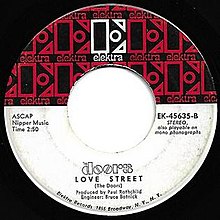| "Love Street" | ||||
|---|---|---|---|---|
 | ||||
| Single by the Doors | ||||
| from the album Waiting for the Sun | ||||
| A-side | "Hello, I Love You" | |||
| Released | June 1968 | |||
| Genre | Baroque rock | |||
| Length | 2:49 | |||
| Label | Elektra | |||
| Songwriter(s) | Jim Morrison | |||
| Producer(s) | Paul A. Rothchild | |||
| The Doors singles chronology | ||||
| ||||
"Love Street" is a song performed by the American rock band the Doors. Sequenced as the second album track on Waiting for the Sun (1968), its lyrics were written by lead singer Jim Morrison and as with other songs, it was dedicated to his girlfriend Pamela Courson.
The song features a departure from the Doors' usual psychedelic style, being a conventional ballad with mainly an acoustic instrumentation. Incorporating elements from classical music, it is described by critics as having a baroque pop aesthetic. Lyrically, "Love Street" is generally considered a simple love song to Morrison's companion, Pamela Courson.
"Love Street" was rarely played in live concerts by the group; however, one performance can be found in a concert in Stockholm, Sweden during their 1968 European tour.
Background
The song was originally a poem written by singer Jim Morrison about the street in the Laurel Canyon section of Los Angeles, California, where he lived with his girlfriend Pamela Courson and watched hippies pass by.
The song is noted for Morrison's spoken narration, which occurs in the middle of the composition:
I see you live on Love Street
There's this store where the creatures meet
I wonder what they do in there?
Summer Sunday and a year
I guess I like it fine, so far
The verse end on an ambiguous note (with the line "I guess I like it fine so far"). Morrison refers to the Canyon Country Store across the street from his house. Morrison also wrote the majority of Waiting for the Sun album and much of The Soft Parade at the residence. The house was partially damaged during a spate of arson fires on December 30, 2011; the balcony was destroyed.
Critical reception
Upon release, Morrison reported that he preferred "Love Street" over its A-side, "Hello, I Love You", which he said was surely not "one of our best". "Love Street" has been praised by many critics for its conventional style, with The Guardian ranking it as the 27th greatest Doors song. Rolling Stone critic Narendra Kusnur considered it one of Morrison's 10 most underrated songs, particularly praising his vocal performance. In an AllMusic review, critic Lindsay Planer called it a "spry and melodic ballad", while Crawdaddy music critic Paul Williams described it as "edgy, even visionary music." Some singled out its "baroque pop feel".
Doors' drummer John Densmore described Ray Manzarek's solo during the bridge as "not flashy", but he expressed that it "gets me off every time because the phrasing is so strong, precise, and simultaneously relaxed." Planer also praised Ray Manzarek's keyboard playing as being "intricate and melodic" in the bridges but complains that Robby Krieger's "painfully understated and jazzy" guitar playing sometimes gets buried beneath the drums and keyboards. English musician David Bowie had cited "Love Street" as one of his all-time favorite songs.
References
- ^ Zaleski, Annie (June 24, 2021). "The Doors' Greatest Songs – Ranked!". The Guardian. Retrieved February 21, 2022.
- ^ Planer, Lindsay. "The Doors: Love Street – Review". AllMusic. Retrieved January 24, 2020.
- ^ Weidman, Rich (2011). The Doors FAQ. Backbeat Books. pp. 197–198. ISBN 978-1617131141.
- Davis, Stephen (2005). Jim Morrison: Life, Death, Legend. Penguin. ISBN 978-1101218273.
- Sounes, Howard (2013). 27: A History of the 27 Club Through the Lives of Brian Jones, Jimi Hendrix, Janis Joplin, Jim Morrison, Kurt Cobain, and Amy Winehouse. Da Capo. p. 124. ISBN 978-0306821684.
- ^ Kusnur, Narendra (July 3, 2021). "On his 50th Death Anniversary: The Underrated Gems of Jim Morrison". Rolling Stone India. Retrieved March 11, 2022.
- Wilson, Simone (December 30, 2011). "Jim Morrison's 'Love Street' House Catches Fire in Hollywood Arson Spree: Balcony That Inspired the Song Burns". LA Weekly. Retrieved January 24, 2020.
- Rutherford, Glenn (October 17, 1968). "Elvis Influenced". Thedoors.com. Retrieved December 16, 2023.
- Wall, Mick (October 30, 2014). Love Becomes a Funeral Pyre. UK: Hachette. p. 201. ISBN 978-1409151258.
- Blistein, Jon. "The Doors' John Densmore on His Eternal Musical and Spiritual Bond with Ray Manzarek". Rolling Stone. Retrieved February 18, 2021.
- Far Out staff (January 16, 2021). "Listen to David Bowie pick his favourite songs ever". Far Out Magazine. Retrieved April 10, 2023.
- Benitez-Eves, Tina (September 24, 2022). "7 of David Bowie's Favorite Songs". American Songwriter. Retrieved April 10, 2023.
External links
- Ms. Mojo. "He Lived on Love Street". waitingforthesun.net. Retrieved January 24, 2020.
| The Doors songs | |
|---|---|
| The Doors | |
| Strange Days | |
| Waiting for the Sun | |
| The Soft Parade | |
| Morrison Hotel | |
| Absolutely Live | |
| L.A. Woman | |
| Full Circle | |
| Alive, She Cried | |
| Featured singles | |
| Other songs | |